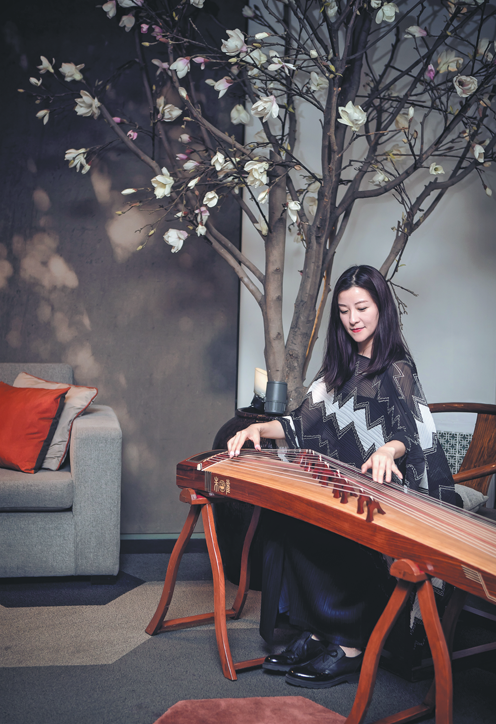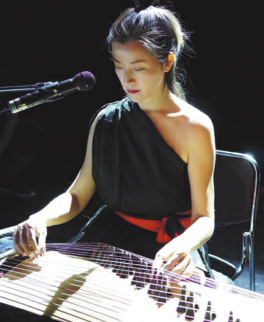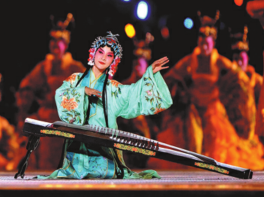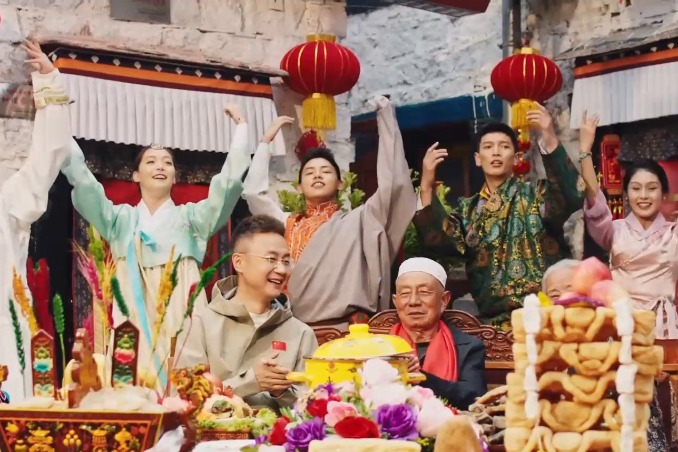Musician mixes tradition in combining East and West
Ancient Chinese instrument revives classical French pieces, Chen Nan reports.

In a harmonious fusion of the East and the West, Chinese guzheng (ancient zither) virtuoso Chang Jing captivates audiences worldwide with her unique style. Last December, commissioned by streaming service Apple Music, Chang adapted three of Claude Debussy's enchanting compositions: Reverie (Daydream), Clair de Lune (Moonlight) and Reflets dans l'eau (Reflections in the Water).
The adaptations allowed Chang to have a spiritual dialogue with the French composer, who was influenced by the beauty of Eastern culture.
Early this year, Chang adapted music pieces from two other French composers: Erik Satie and Maurice Ravel.
The adaptations turned out to be three parts of Chang's upcoming new album Red White Blue, which was released on Friday — the same day of the opening ceremony of the Paris 2024 Olympic Games.
She named each of the three French composers' works as colors of the French national flag: Ravel is red, Debussy is white and Satie is blue.
Known for its delicate tones and rich history, the guzheng, a traditional Chinese instrument, might seem an unlikely one to interpret the works of renowned French composers. However, Chang's mastery transcends cultural boundaries, demonstrating the universal language of music. Her musical explorations exemplify the transformative power of creativity and cross-cultural dialogue through music.
"My interest in French music started with Debussy. In his works, I could feel that the composer tried to use the piano to portray the landscape of the East. He possibly encountered some challenges since the piano may not fully display his musical ideas. But for the guzheng, an ancient Chinese musical instrument, it may be able to achieve what the composer tried to express," says Chang, who envisioned how the French composer wrote the music pieces, as she says, "like traveling back to Debussy's days and having a talk with him".
Chang stays loyal to Debussy's scores as well as integrating her own ideas.
"There are some music notes on his scores which cannot be produced by the guzheng, so I made some changes, taking some notes out as well as adding notes that I believed to be harmonious to fit the scores," Chang adds.
She chose to adapt Ravel's two music works Bolero and Pavane Pour une Infante Defunte (Pavane for a Dead Princess), which are well-known worldwide.
"The relentless snare drum underpins the whole of the 15-minute piece as Ravel inexorably builds on the simple tune until the last part when he finally releases the tension with a burst of rhythms like fireworks," says Chang, talking about Bolero.
"I couldn't make the orchestral sound with the guzheng, but what I could do was to leave some space for the listeners to imagine," says Chang. "It's just like traditional Chinese ink painting, which has a technique called liubai, or leaving blank space. The core spirit of the technique is to use less to achieve more."
As for Satie, Chang adapted three music pieces from two of the French composer's works: Trois Gnossiennes and Trois Gymnopedies.
Unlike Ravel and Debussy's works, which Chang recorded in a professional recording room in Beijing — with 14 microphones surrounding her "like a universe" — Chang recorded music works by Satie at her room when she stayed in Bangkok, Thailand.
"It was raining all day and I tried to close the window to avoid noise when I recorded the pieces. But I couldn't help listening to the rain and I opened the window, letting it be a part of the recording," says Chang. "I also recorded the natural sounds, like birds chirping and the people passing by my window, which was a totally different 'universe' compared to a professional recording studio. I rarely record that way, which was very interesting and enriched my music performance."
This recording not only adds a sense of authenticity and immediacy but also expands the sonic palette of the guzheng, transforming it into a medium for capturing the essence of urban and natural environments.
She adds that the fresh experience of recording reminded her of a trip over 20 years ago when she toured Europe with a jazz band. She stayed in the home of one of the jazz musicians where they recorded together.
"When the jazz musician's cat ran around the room, I expected him to take the cat out. However, he let the cat play in the room and told me that it was part of his music," recalls Chang. "For musicians, keeping an open heart is very inspiring."
"Her interpretations not only pay homage to the original compositions but also imbue them with a distinctive Eastern sensibility, creating a transcendent auditory experience," says Zhang Di, a musician specializing in playing the traditional Chinese musical instruments flute and xiao (a vertical bamboo flute), who worked with Chang on her new album. "We want to encourage a broader appreciation for both Chinese and Western musical traditions, enriching the global musical landscape."
Born in Chengdu, capital of Sichuan province, Chang began studying the guzheng at the age of 8. She later graduated from China Conservatory of Music and became a performer with the China Oriental Performing Arts Group.
With a long history tracing back to the Warring States Period (475-221 BC), the guzheng has evolved into a symbol of Chinese cultural heritage and an artistic expression of Chinese music.
Its 21 strings, delicately plucked by the musician's fingertips, produce a range of tones that evoke the serene landscapes and profound philosophies of Chinese tradition. Chang has elevated the instrument to new heights through her innovative approach and technical prowess.
Though she is best known for her performance of the classic Chinese music piece The Moon Over the River on a Spring Night at the opening ceremony of the Beijing Summer Olympics in 2008, she is more often seen playing the guzheng in unconventional ways and has been keen on experimenting with new sounds on the instrument.
She recorded for films such as Zhang Yimou's The Love of the Hawthorn Tree and Wong Kar-wai's Ashes of Time, and in 2010, she founded an ensemble that consisted of both the guzheng and Western instruments, like the violin and piano.



Today's Top News
- Israel's Gaza takeover plan widely condemned
- S. Korea visa waiver spurs surge in travel interest
- Top cities signal easing to support property market
- Ties bolster heritage protection
- Gaza 'takeover' will ignite another horrific chapter for the Middle East: China Daily editorial
- STAR shines for innovative companies






























